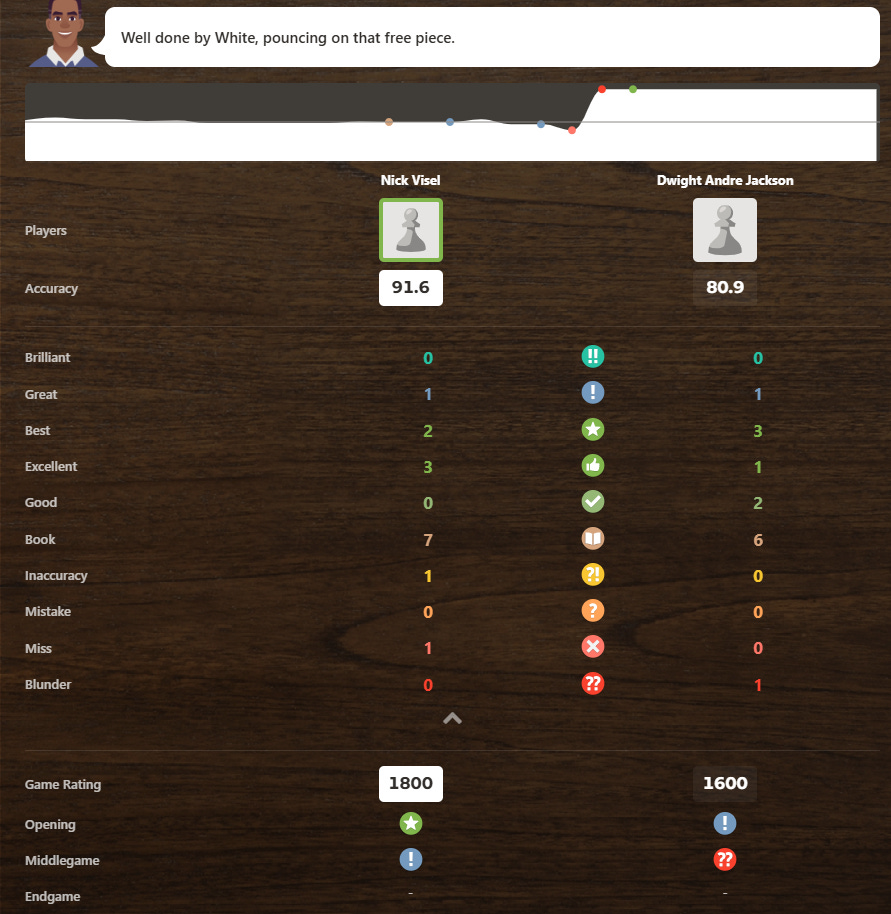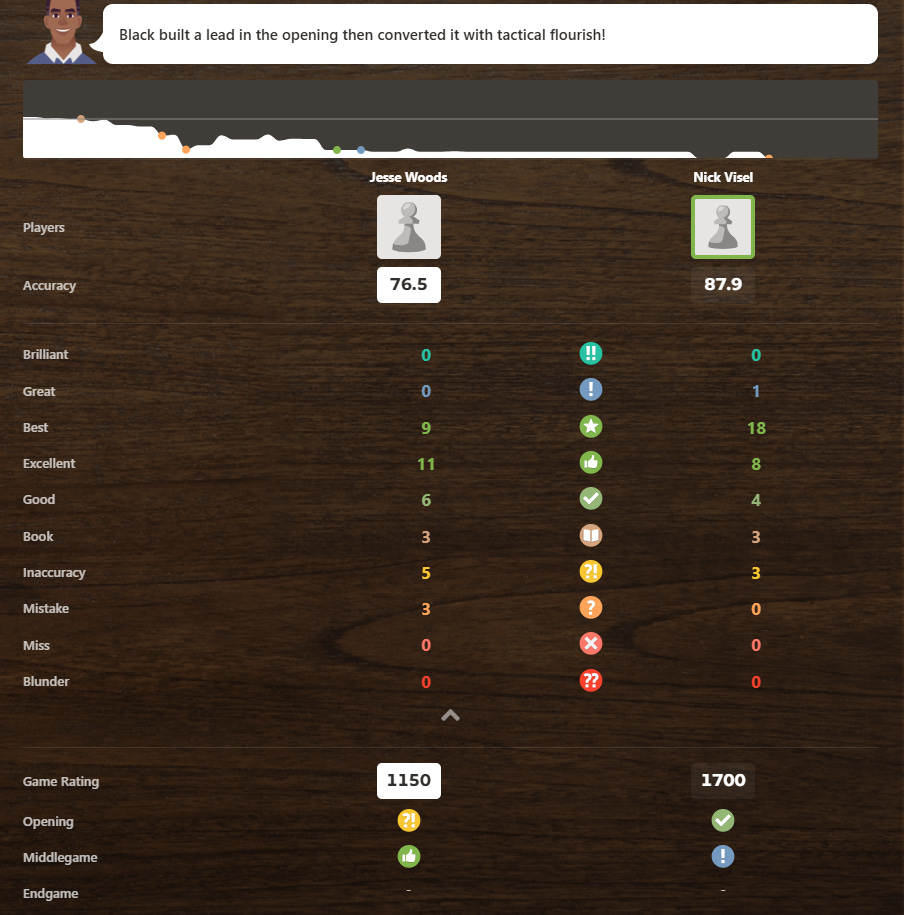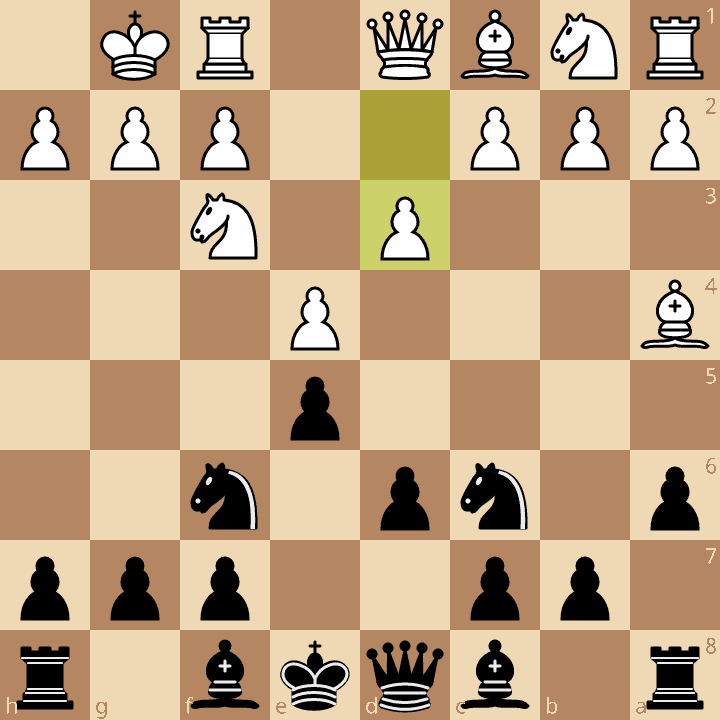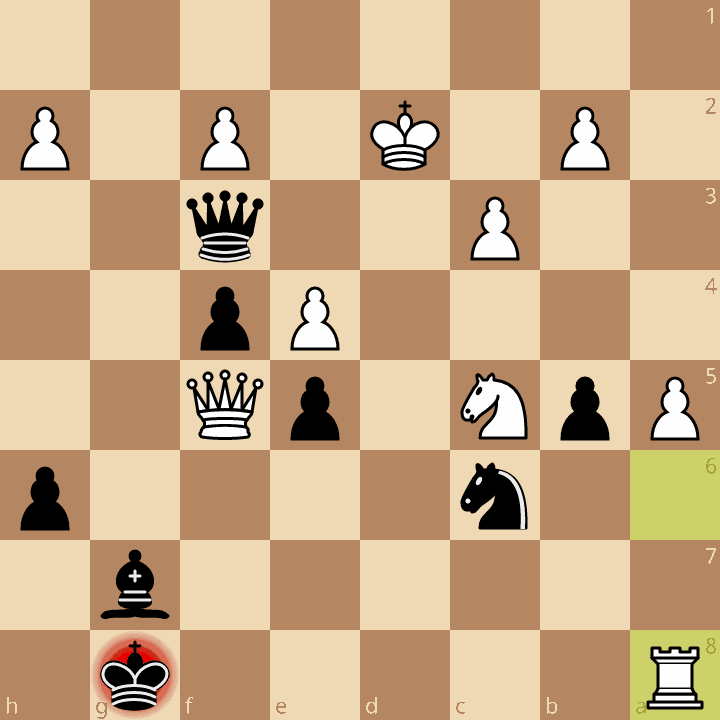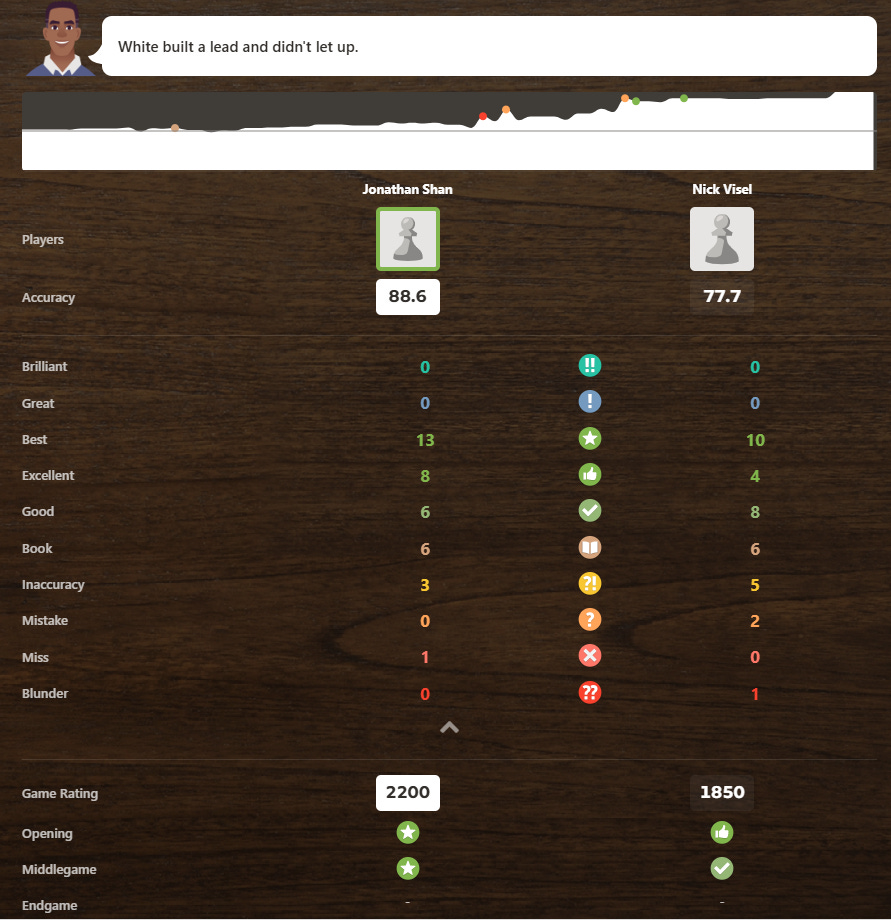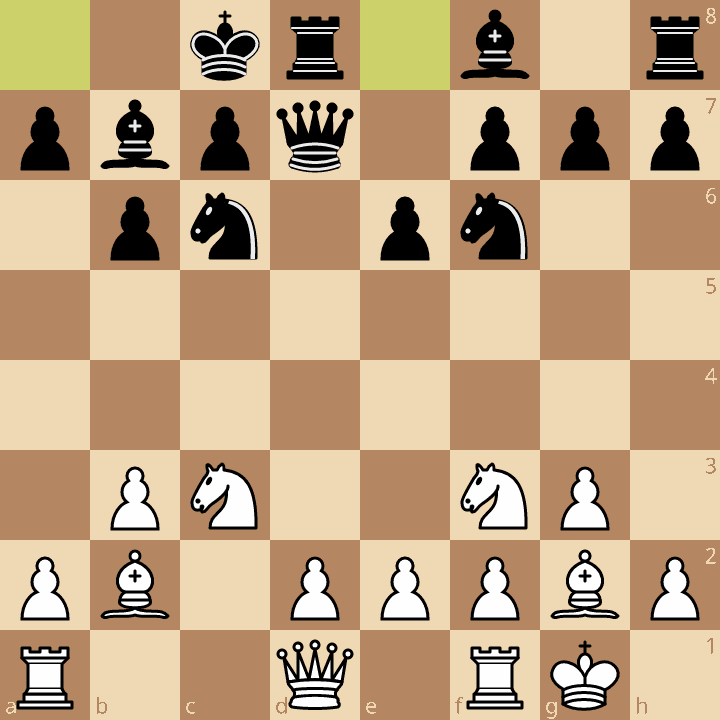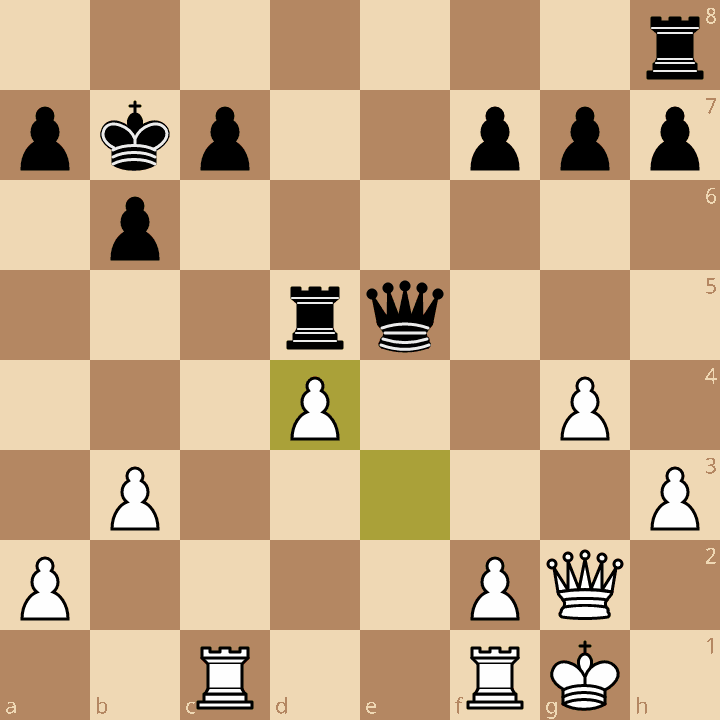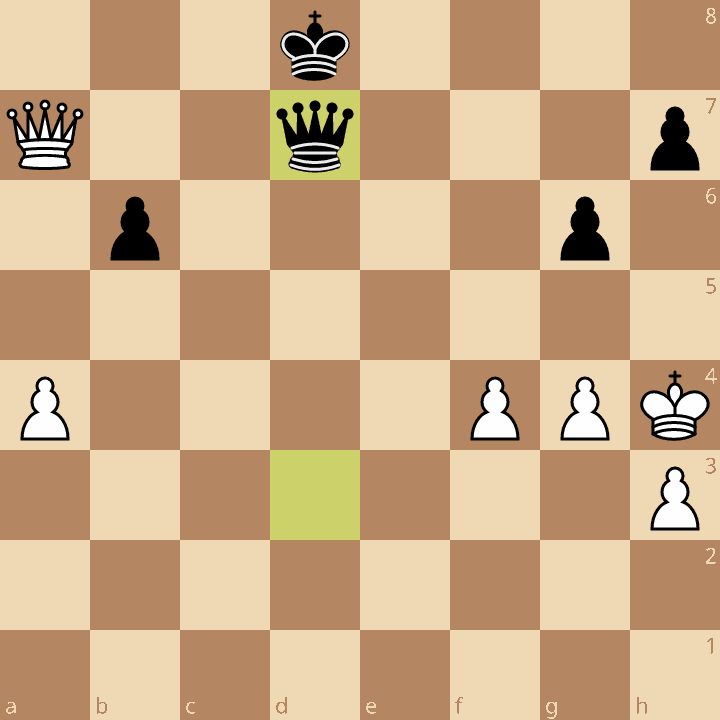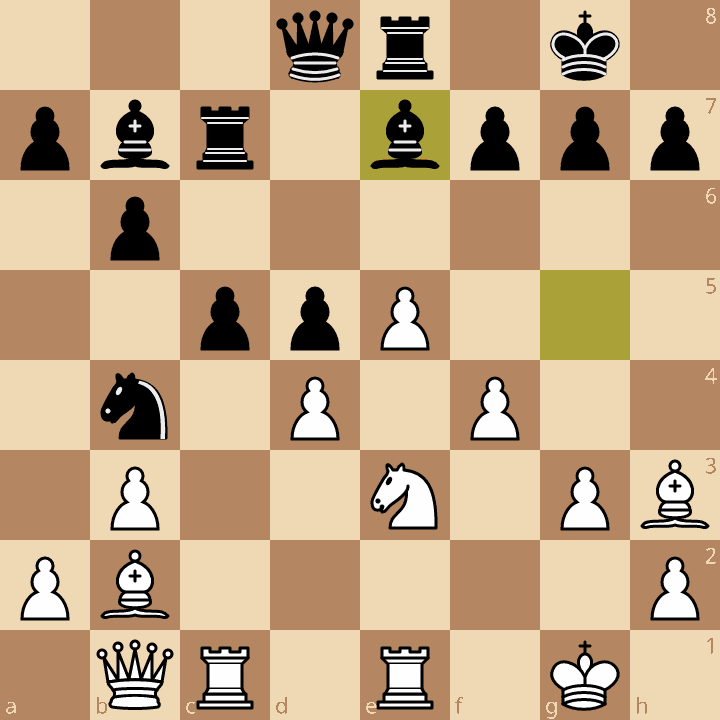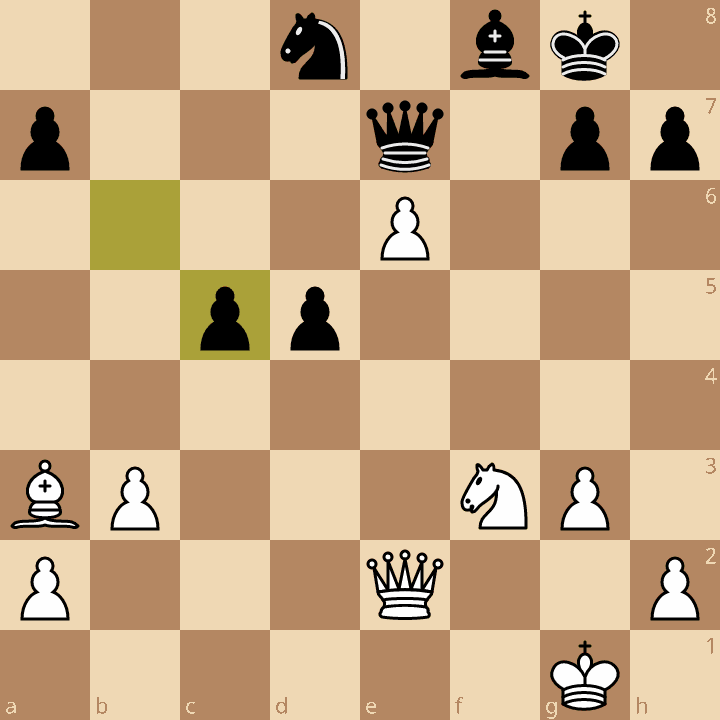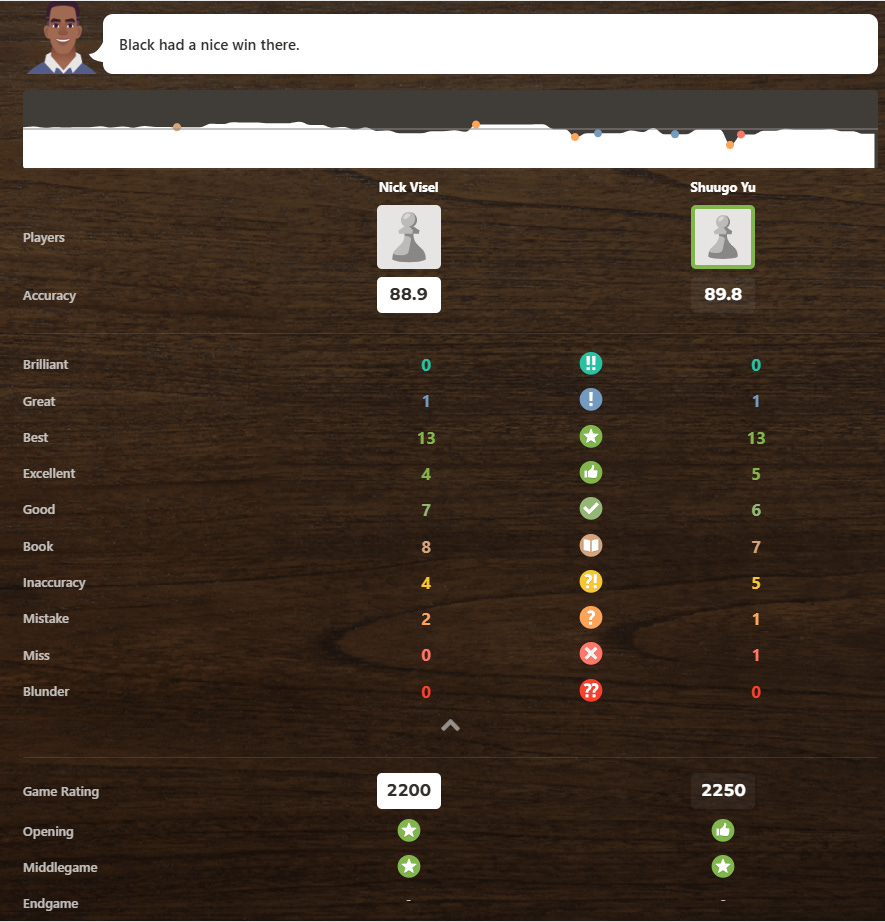2024 Sacramento Chess Club Championship Recap
Taking a look at each of the games I played over the last two months
The 2024 edition of my local club’s championship (not to be confused with the Sacramento Chess Championship) ran from September 24 to November 12 this year. Compared to last year, the roster had a lot of newcomers, many of them strong adult players either returning to OTB after a long break or giving it their first real try.
For me, entering into this tournament I felt pretty apprehensive, as I had felt a lot of burnout and had been taking a step back from rigorously studying and practicing. I expected to have some rust to shake off. Nevertheless, I wanted to at least maintain my game habit even if not my studying, which I had given myself about two months reprieve from. I just needed to regain some of the earlier fire I had for trying to improve, and I didn’t want to become out of practice.
My final score for the tournament was 5/10. I won two games straight away, but followed those two wins with two losses. From there I won two more games, lost a tough one, and then won the final game. Overall, I ended up dropping some rating points since my tournament performance rating wasn’t very high (due to the two low-rated players I first played). Nevertheless it was a positive experience, I learned a lot, and by the end of the tournament I was really ready to begin studying hard again. I’ve been hitting the books hard.
Here is how the games went.
Game 1
Nick Visel (1601) - Dwight Jackson (636)
Evans Gambit
1.Nf3 Nc6 2.e4 e5 3.Bc4 Bc5 4.b4!?
The Evans Gambit is close to my heart. It’s the first 1.e4 opening that I decided to learn in earnest a few years ago, and I have many fond memories of playing swashbuckling chess with this line. As I was in the mood for messing around and not thinking too deeply, I chose to go here over something more solid like 4.c3 and 5.d3. The benefit of this line is that Black’s line to equality is tricky — natural moves don’t necessarily lead to good outcomes and though White can end up down two, sometimes three pawns, the initiative and ability to make strong threats gives full compensation for the missing material.
4…Bxb4 5.c3 Ba5! 6.d4 exd4 7.Qb3 Qe7 8.O-O Nf6
So far Black has played the opening well. I’m the first to make a mistake.
9.Ba3?!
This is thematic in the Evans Gambit, seeking to trap the king in the center, but I mixed up my move orders, which allows Black to counter strongly in the center. I should have instead played 9.cxd4 Nxe4! (9…O-O? 10.e5! followed by 11.Nc3 or 11.Bg5) 10.Ba3! and whether Black chooses 10…d6 or 10…Nd6, White has a nice initiative, and continue developing with Nc3 or Nbd2, followed by bringing a rook to e1 to harass the queen and grab the open e-file.
9…d6! 10.e5?
I had to play 10.cxd4 to cut my losses and prepare e5. As it stands, this pawn sacrifice is unsound. I stepped away from my board to stretch my legs and give my opponent some time to think.
10…dxe5??
Blundering the queen. 10…Nxe5! gave a nice advantage after 11.Nxe5 Qxe5 12.Bxf7 Kd8! My opponent sighed and a few minutes later the game was over. The conclusion was:
11.Bxe7 Kxe7 12.cxd4 exd4 13.Nxd4 Re8 14.Nxc6+ bxc6 15.Qa3+ 1-0
The bishop comes off the board. Black resigned.
The chess.com report card is pretty optimistic, but I was honestly pretty annoyed by my poor pawn moves in the center. Had my opponent not blundered his queen early, it may have been difficult to turn around.
Game 2
Jesse Woods (494) - Nick Visel (1601)
Vienna Game
1.e4 e5 2.Nc3 Nf6 3.g3 Bc5 4.Nf3 d6 5.Bc4?
Very inconsistent with the move 3.g3. White’s king’s position is rather weak. 5.Bg2 was sensible.
5…O-O 6.O-O Nc6 7.Ng5?
Very much a “coffeehouse” move.
8…h6 8.d3!?
This whole piece sacrifice gave me a bit of pause, not because I thought I was in trouble, but because I wanted to think about what possibilities he thought he had. My experience playing Jesse before is that he is rather sharp tactically for a beginner, and isn’t afraid to sacrifice material. Mainly I thought he would go for the typical Four Knights idea of a pin on the queen followed up with Nd5, trying to wreck black’s kingside.
8…hxg5 9.Bxg5 Be6
Since I was up a piece, I wanted to find the simplest path forward to trade down into an endgame without giving him opportunity to complicate with a move like Nd5, taking advantage of the pin. Therefore I decided I would just swap on that square as soon as a piece showed up there.
10.Nd5?!
Of course if 10.Bxe6 fxe6, he never gets to put a piece on the d5 square.
10…Bxd5 11.Bxd5
11…Rb8?!
In hindsight, I see now I could have gone for 11…Nd4! right away: 12.Bxb7 Rb8! and I win the b2 pawn and have some threats on the 2nd rank.
12.h3 Nd4 13.Kh2 Ne6 14.f4 Nxg5 15.fxg5 Nxd5 16.exd5 Qxg5
Up a full piece in the endgame, I’m completely winning. The conversion took a while though.
17.h4 Qe7 (17…Qg6 18.h5 Qg5) 18.Kh3 f5 19.Qh5 Qf7 20.g4 Qxh5 21.gxh5 21…f4 22.Kg4 Rf6 23.Kg5 Rbf8 24.Rf3 Kf7 25.Rg1?? Bxg1 26.c3 Rh8 27.Rf1 Be3 28.Kg4 Rfh6 29.Kf3 Rxh5 30.Ke2 Rxh4 31.Kf3 Rf6 32.Ke4 Rh3 33.b4 Bd2 34.Rf3 g5 35.a3 g4 36.Rxf4+ Bxf4 37.c4 Re3#
Game 3
Nick Visel (1601) - Alonzo McCaulley (1852)
English Opening
1.c4 Nf5 2.g3 g6 3.Bf2 Bg7 4.Nc3 c6?!
5.Nf3?!
Shankland recommends the move 5.e4! The reason is that d5 is virtually stopped in its tracks by this binding move and puts the move c6 into question.
5.O-O 6.O-O d5 7.b3?
This move lands me in a world of hurt and I will lose a pawn. Instead, 7.cxd5 cxd5 8.d4, was equal and easier to play.
7.Ne4! 8.Bb2 Nxc3 9.dxc3 dxc4 10.Qc2!? cxb3 11.axb3 Qb6
I have barely any compensation for the sacrificed pawn. My position collapsed quickly from here.
12.c4 Nd7 13.h4 Bxb2 14.Qxb2 Nf6 15.Rfd1 Bg4 16.Ne5 Rad8 17.Nd3 a6 18.b4 Qd4 19.Qa2 Be6 20.Rac1 Ng4 21.e3 (21.Bf3) Nxe3 22.fxe3 Qxe3 23.Qf2?? (I was trying to save the g3 pawn but this came at the loss of a piece. 23.Nf2 kept the fight going, though Black is still better) Rxd3 0-1
A tough loss, but I felt it was sort of inevitable given my intentionally nonchalant approach to chess over the past couple months. Still, learning that I could have played e4 so early was a wake-up call that I needed to stick to principles and not simply auto-pilot in the opening. Now I’m looking for e4 constantly to bind the d5 square when Black is in a c6-system against the English.
Game 4
Jonathan Shan (1630) - Nick Visel (1601)
Ruy Lopez
1.e4 e5 2.Nf3 Nc6 3.Bb5 a6 4.Ba4 Nf6 5.O-O d6 6.d3
6…Bd7
6…b5 8.Bb3 Na5 is Gawain Jones’s suggestion, as it wins the bishop pair right away.
7.c3 g6 8.Bg5 Bg7 9.Nbd2 O-O 10.Re1 Ne7
This is where I started to go wrong. This move by itself isn’t bad, but I could have played h6 first.
11.d4!
11…Bxa4 12.Qxa4 12.b5?! (12…Nh5) 13.Qc2 Nh5 14.dxe5 dxe5 15.a4 h6 16.Be3 Nf4 17.Nb3! Re8 18.Nc5
Here I have been severely outplayed. My opponent converted the game very smoothly, and while I had some chances to fight back, we were both sinking a lot of time into these moves — the rest of the game went pretty quickly:
18…Qd6 19.Rad1 Qc6 20.Qb3 Reb8 21.g3
21…Nh5?
After a final long think, I chose the wrong move. To continue fighting, I had to try either 21…Nh3! right away or 21…bxa4 followed by Nh3. Now I get crushed as White infiltrates along the d-file.
22.a5 Rd8 23.Rxd8 Rxd8 24.Rd1 Re8? (24…Rd6!) 25.Rd7 Qf6 26.Kg2 Kh7 27.Rxc7 g5 28.Ra7 Nf4+ 29.gxf4 gxf4 30.Rxa6 Nc6 31.Bd2 Qg6+ 32.Kf1 Qg4 33.Ke2 Rd8 34.Qxf7 Rxd2 35.Kxd2 Qxf3 36.Qf5+ Kg8 37.Ra8+ 1-0
Game 5
Nick Visel (1601) - Takeo Caridad (991)
English Opening
1.c4 e6 2.g3 Nf6 3.Bg2 Nc6? 4.Nf3 b6 5.O-O Bb7 6.b3 d5 7.cxd5 Qxd5 8.Nc3 Qd7 9.Bb2 O-O-O!?
This felt quite sharp and the position is pretty exciting for me: I’ve never really gotten an opposite-sides castled position in the English, and with the open c-file, I felt like my chances to win were rather decent. Statistically, the lichess database shows that White scores 37.5% here (+2/-4/=2), but the evaluation Stockfish gives implies that White has a slight edge.
10.d3 Ng4? 11.Rc1 Nd4??
The first knight move was extraneous. But this last one is simply losing. However, my tactical awareness was still suffering, and so I missed a simple win here.
12.e3?
12.Nxd4! wins a piece right away, and if Black tries to win the recapture the d4-Knight via 12…Bxg2 13.Kxg2 Qxd4 then white has 14.e3 (double attack!) Qb4 15.a3, and the knight on g4 cannot be saved (diagram):
12…Nb5 13.Nxb5 Qxb5 14.Nd4! (h3 was also a possibility) Qh5 15.Bxb7+ (h3 should have been played) Kxb7 16.Qf3 Rd5 17.Qg2
By a series of unfortunate decisions, any advantage I might have had is completely lost and the position is equal. Black has an initiative against my kingside and his pieces are starting to spring into activity. Had I played h3 at any point prior to this point, there’d be no threat against the king and I’d be able to wrest the initiative from him. As it stands now, I have some problems to deal with.
17…Bc5? 18.h3?
I was seeing ghosts of a threat against the e3 square, but missed that 18.Nc2 (threatening b4 or h3 next move) was strong.
18…Ne5
Now I’m forced into the following sequence which should lead me into an endgame where I’m on the worse side of a probable draw.
19.g4 Qg6 20.Nxe6! Qxe6 21.Bxe5 Qxe5 22.d4! (the point) Bxd4 23.exd4
23…Qd6!
The correct response. If 23…Qxd4?? then 24.Rcd1 wins the pinned rook.
24.Rc4 (Rfe1 was probably better) c6 25.Rfc1 Rc8 26.Qe4 g6 27.b4 Rc7 28.a4
28…Re7?
This move is a waste of time. Instead, Black could have waited with almost any pawn move and the position would remain dynamically equal.
29.Qf3! Rc7? (Rd7, avoiding the pin) 30.b5! Rxd4
31.Rxc6?!
Another tactical oversight! 31.Rxd4 won right away: 31…Qxd4 32.Rxc6 Rxc6 33.Qxc6 Kb8 34.Qe8 Kc7 35.Qxf7 and White will clean up the kingside pawns, giving him multiple passed pawns that cannot be opposed by the lone queen.
31…Rxc6 32.bxc6 Kc8 33.Qxf7 Rd1+ 34.Rxd1 Qxd1+ 35.Kg2 Qd6 36.Qb7+ Kd8
37.Qxa7?
Compromising the win. I should have gone with 37.Qa8+ followed by Qxa7+ with tempo. Black wins the c6-pawn but after 37…Kc7 38.Qxa7+ Kxc6 39.Qf7! Black has no checks and White continues to be a pawn up in a technically won position.
37…Qxc6+! 39.Kg3 Qd6+ 49.f4 Qd3+? (Qd4!) 40.Kh4 Qd7
41.Qxb6+
A simpler win was 41.Qxd7+! Kxd7 42.f5! gxf5 43.gxf5 Kc6 44.Kg5 Kd6 45.Kh6 Ke5 46.Kg5! and Black is in zugzwang:
Black’s king must eventually give way to allow Kf6, or otherwise push h6 allowing Kg6.
The game ended quickly after this.
41…Ke7 42.a5 Qd1 43.Qc7+ Kf6 44.g5+ Kf5? (shortening the end) 45.Qe5#
A rough win with many mistakes.
Game 6
David Duncan - Nick Visel
Two Knights Defense
1.e4 e5 2.Nf3 Nc6 3.Bc4 Nf6 4.Ng5 d5 5.exd5 Na5 6.Bb5+ c6 7.dxc6 bxc6 8.Be2 h6 9.Nh3!?
This arcane move marks the “Steinitz Variation” of the Knight Attack in the Two Knights Defense. The obvious goad: White wants Black to give up a bishop and open the g-file. I have no interest into falling into this idea.
9…Bc5 (9…Bd6 is Jones and Gustaffson’s recommendations) 10.O-O O-O 11.d3 Be6 12.Be3? Bxe3! 13.fxe3 Nd5! 14.Rf3
14…Rb8? (14…Qb6!) 15.e4??
Losing immediately. Instead, c4, attacking the d5 knight with the other pawn without opening up the king to a check on the weak diagonal, was an improvement and equalizes.
15…Qb6+ 16.Kh1 Qxb2 17.Nd2 Nc3!
18.Qf1 Qxc2 19.Qe1 Rb2! 20.Rg3!? (setting up a desperado attack — he’s got nothing else practical to try) Qxd2 21.Rxg7+ Kxg7 22.Qg3+ Kh7 (White is out of checks) 23.Rf1 Qxe2 0-1
Black wins easily. For instance even lazily giving back some material with 24…Qxg2+ 25.Qxg2 Rxg2 26.Kxg2 Bxh3+ leaves Black up two knights and a pawn. This was by far the most important win for me in this tournament. David is a strong player so I was glad to beat him and regain some more momentum. It’s also the most accurate game I played in this tournament.
Game 7
Nick Visel (1601) - Shuugo Yu (1563)
English Opening
1.c4 c6 2.g3 d5 3.Nf3 Nf6 4.Bg2 e6 5.O-O
5.b3 isn’t bad either.
5…Be7 6.Qc2 Nbd7 7.b3 O-O 8.Bb2 Re8
Black has played a very cramped but solid game. I thought for a while here, trying to figure out how bet to continue. In the end I’m very happy with the plan I came up with.
9.d3!
9.d4 is also good, transposing into a Catalan.
9…Nf8!? 10.e4! c5 11.e5! N6d7 12.xcd5 exd5 13.d4!
This was the position I envisioned when calculating on move 9. I have in mind moves like Nbd2 or Nc3, and rooks to some combination of the c-, d-, and e-files. I like the strong center, the fact that trading on d4 leaves Black with an isolani, and some attacking chances on the kingside as well as pressure on Black’s center.
13…b6 14.Re1?!
14.Nc3! was called for, even here. It puts a lot of pressure on the d5 pawn which is a bit weak, having to be defended by a piece.
14…Bb7 15.Nbd2?!
Two moves later I have squandered the last of my positional advantage. 15.Nc3! was better.
15…Rc8 16.Qd3 Nb8! 17.Rac1 Nc6
Now Black’s position looks a bit more active. To start, my queen is awkwardly placed and I have to be vigilant for Nb4 ideas. My play on the queenside has been interrupted which means that now I don’t have time to go for anything on the kingside, since Black is putting a lot of pressure on my center.
18.Bh3?!
Too fancy! 18.Nf1-e3, giving my knight a future, was better. I could also admit that Re1 was a waste of time and play 18.Red1 instead.
18…Ne6! 19.Nf1 Nb4! 20.Qb1
Black has a clear initiative now, and I have to find a plan to fight back.
20…Rc7 21.Ne3 Ng5?
A mistake, since it allows me to start an attack with tempo on the kingside, where most of my pieces are oriented.
22.Nxg5! Bxg5 23.f4 Be7
24.e6! Bf8! 25.exf7+?
Premature. I should have started with 25.a3 to kick the knight from the queenside. (it has been threatening the d3 fork for a while now). If 25…Nc6?! (Na6, to recapture on c5 is better) 26.dxc5 bxc5 (26…fxe6 27.cxb6 axb6 28.b4 d4 29.Rcd1, and White has a nagging initiative) 27.exf7+ Rxf7 28.Bf5 and Black probably has to give up an exchange immediately or lose a pawn while he’s at it. Supposing 28…Rxf5, though, Black is still surviving according to Stockfish 17 on Lichess’s analysis board.
25…Rxf7!
I don’t know why I didn’t see this move but it caught me by surprise. Probably the stress of the low time factor coming into play.
26.Nf5?
26.Ng4, redirecting to e5 was advisable. or 26…a3, preventing Black’s next.
26…Ba6 27.Rxe8 Qxe8 28.Re1 Qd8 29.Nh4 Bc8?!
Giving up on the fork threat on d3. Instead, Black should have gone for it. 29…Nd3! 30.Be6 Nxe1 31.Qxe1 Bc8 32.Bxf7 Kxf7, and Black has good chances in the endgame thanks to his bishop pair — particularly the presence of the light square bishop which has no counterpart and leaves White’s king position airy (see diagram)
30.Be6?
Failing to capitalize, and giving Black better chances by wasting time. 30.Bxc8! Qxc8 31.a3! Nc6 and White can either trade on c5 messing up Black’s structure a bit, or bring the knight back into the game via the f3-square. The line I choose leaves me in an inflexible position and Black has a lot of time to make threats and build pressure on my increasingly spotty pawn structure, which means I have to rely on activity to create counterplay. This is hard to do when one is low on time.
30…Bxe6! 31.Rxe6 Re7 32.Qf5 Rf7 33.Qe5??
33…Qd7?
33…Nd3! 34.Qe2 Nxf4!! 35.gxf4 Qxh4! was a catastrophic loss for White.
34.Qe2 Re7 35.f5 Nc6 36.Nf3 Rxe6 37.fxe6 Qe7 38.Ba3?! Nd8 39.dxc5 bxc5 0-1
My flag fell.
I haven’t run out of time like this in a classical game in a long time — possibly ever. My next move was going to be Qb5, but in the case of any move by White, Black has an edge. It was disappointing for the game to end this way as I struggled under so much time — but I had a number of moments and ideas I was happy to have found. My opponent played well — and now I’m 0 for 2 against him after having lost to him back in July at the Sacramento Chess Championship.
Game 8
Eric Arevalo (unrated) - Nick Visel (1601)
King’s Gambit
1.e4 e5 2.f4 exf4 3.Nf3 Nf6 4.e5 Nh5 5.d4 d6!?
5…d5! was the Morphian move that should have sprung to mind immediately, given I’d been reading a book of his games recently.
6.Bc4 Be7
6…d5 was a legitimate option and still just as strong as on the previous move but was rejected because moving a pawn two squares in two moves is psychological difficult to do in the opening. 6…dxe5?! 7.Bxf7+! Kxf7 8.Nxe5 Kg8 9.Qxh5 would be awful.
7.O-O O-O
8.Ne1?
This undeveloping move tries to attack the knight on h5, but since Black plans on playing g6 anyway, why pay for his tempo? Afterward my opponent bewailed not having played 8.c3, but I would think 8.Nc3 is even stronger.
8…g6
8…dxe5! works too, thanks to the trick 9.Qxh5?? Qxd4+! which leaves Black up three central pawns.
9.Be2?!
Everything I said about move 8 applies here.
9…Ng7 10.Bxf4 dxe5 11.Bxe5 Nc6 (winning the bishop pair) 12.Nf3
12…Bxg7 gives up attacking prospects but minimizes Black’s edge.
12…Nxe5 13.Nxe5 Nf5 14.Rf4?! Bg5 15.Re4 Ne3?!
15…Be3+ 16.Kh1 Bxd4 17.Nc3 Bxc3 18.bxc3 Qxd1+ 19.Rxd1 won a pawn, but I wanted more. However, the best way to win the exchange was immediately with 15…Nd6!
16.Qd3 Bf5 17.Nc3 Bxe4 18.Nxe4
18…Bh6?!
This allows White a cheeky combination to win back material, but I had an idea in mind with this move.
19.Ng4??
Black is still winning if White finds 19.Nd7! winning back the exchange due to 19…Qxd7?? 20.Nf6+!, but it’s harder for Black to prove it. I had wanted to maintain the knight’s presence on e3 for one more turn, so that if White went completely off the rails (for instance, with a move like 19.g4?! (trying to cut the knight off completely), Black has 19…Nxc2! winning a pawn (e.g. 20.Qxc2? Qxd4! picking up the now-loose knight on e5.
19…Nxg4 20.Bxg4 f5! 21.Qc4+ Kh8 22.Nc5 fxg4 23.Ne6
23…Qf6 24.d5!? Rf7 25.Re1 Qf2+! 0-1
End Results:
Total Score 5/8
Rating change: -12 (1601 → 1589)
Score with White: 2/4
Score with Black: 3/4
I’m not too displeased with the results. Coming back from some tough losses was important to maintain my mental composure here, and I also had to remind myself that I shouldn’t expect miracles, having taken a break from studying for the majority of this tournament. In the end I drew some lessons from each of the losses, but especially the game I played with Shuugo.
There is one more classical time control tournament left this year at the club — I’m hoping to score well there as well. But the good news is that despite the rating loss this was a good result, sharing 5th place with a couple others in a field of 35 players. I feel very motivated to study chess and have been digging deeper into the books the last couple weeks.
I didn’t lose the game in the opening, but my loss against Alonzo showed me an issue I had with understanding how to meet these early c6-lines in the English. The loss against Jonathan showed me that I need to study the Deferred Steinitz lines more to understand the plans. Missing a chance to pick up the bishop pair in the opening so soon in a critical line like that was frankly amateurish of me. And lastly, I played well against Shuugo but ran out of time. Calculation practice may help me speed up a bit — and it’s one of my priorities right now.
If you made it this far or read any of this analysis, thank you! (and I’m sorry).







